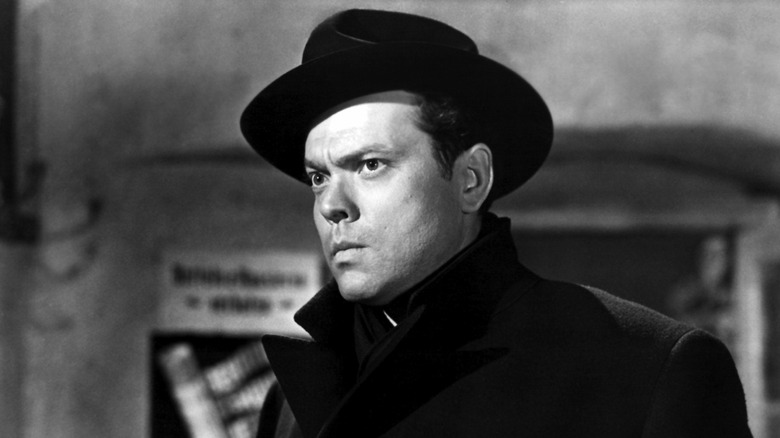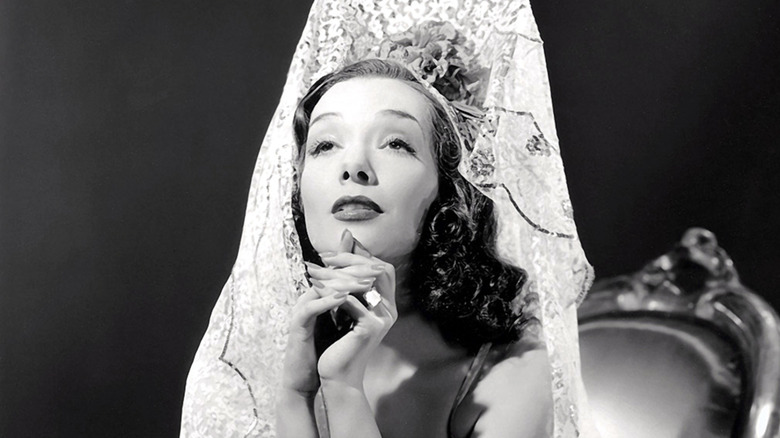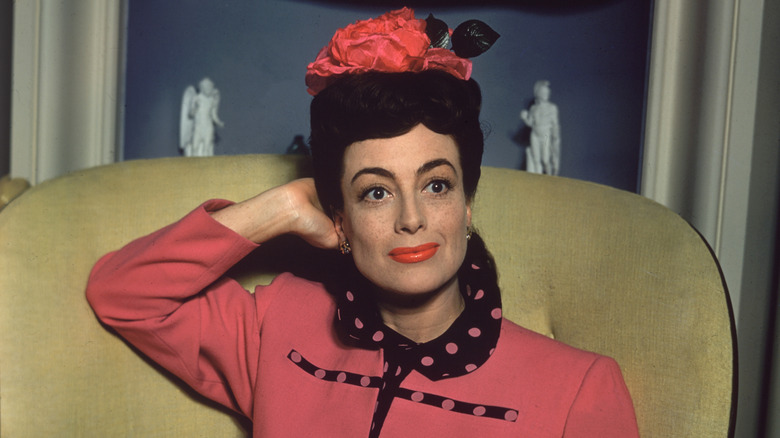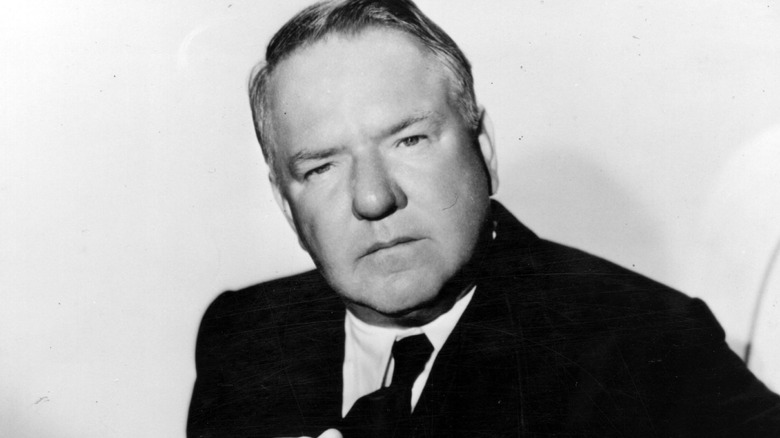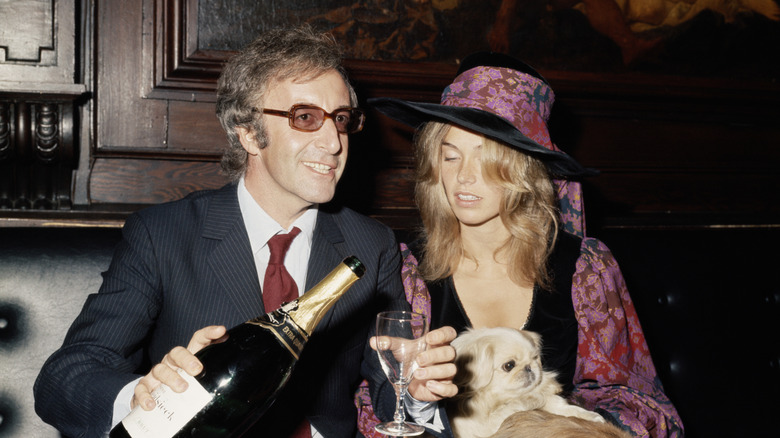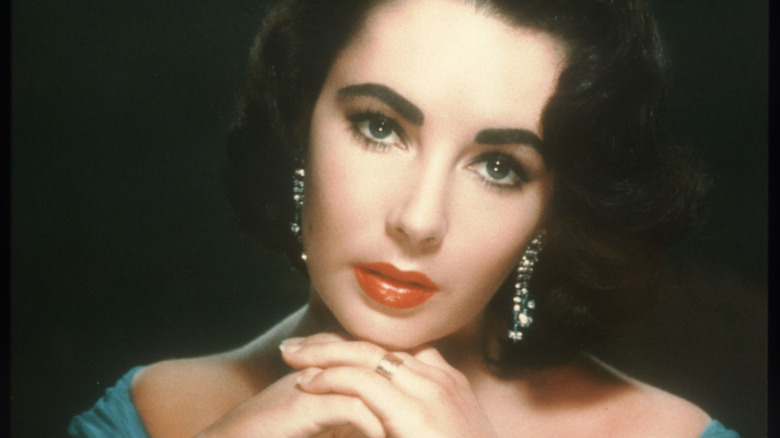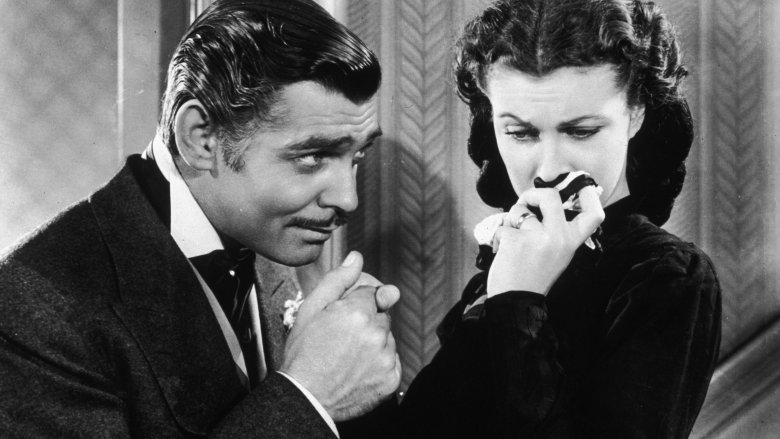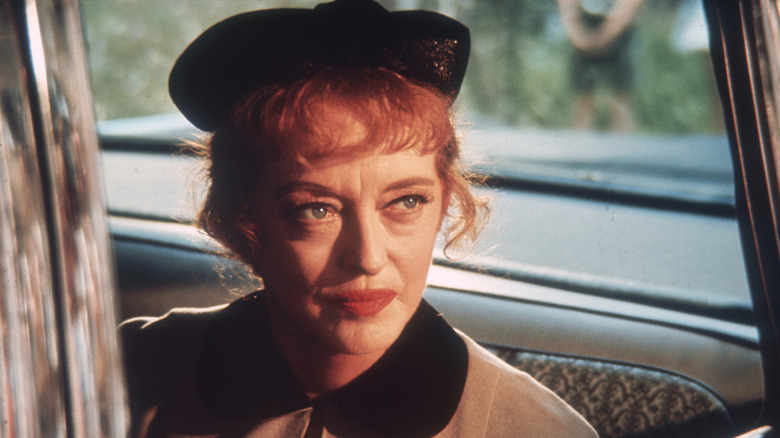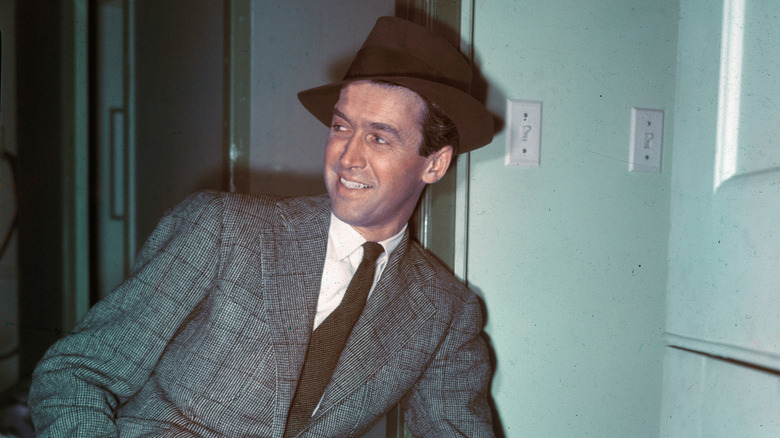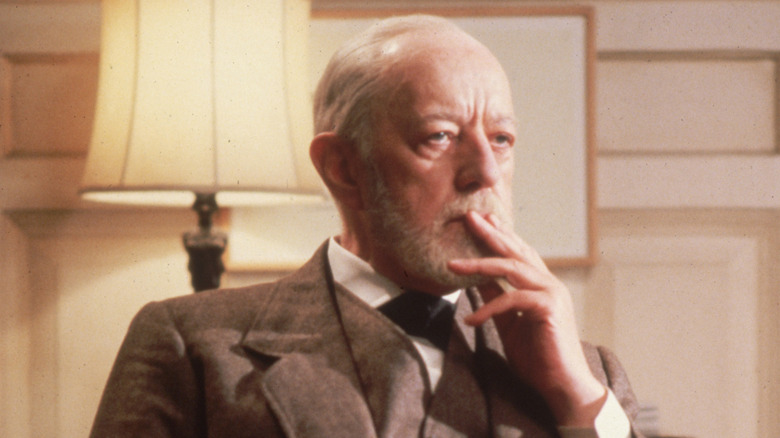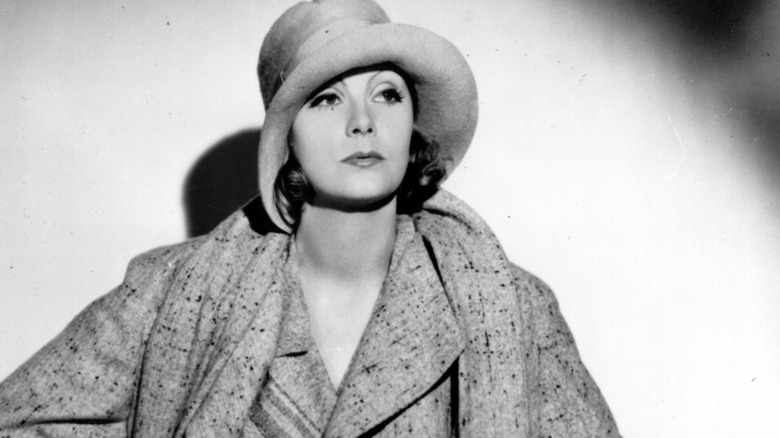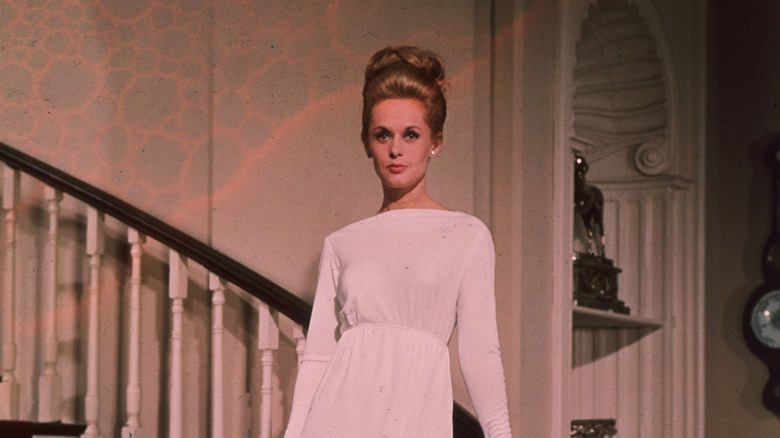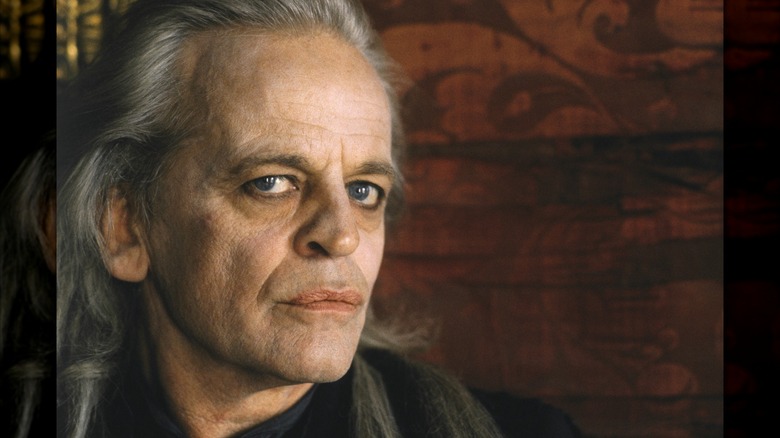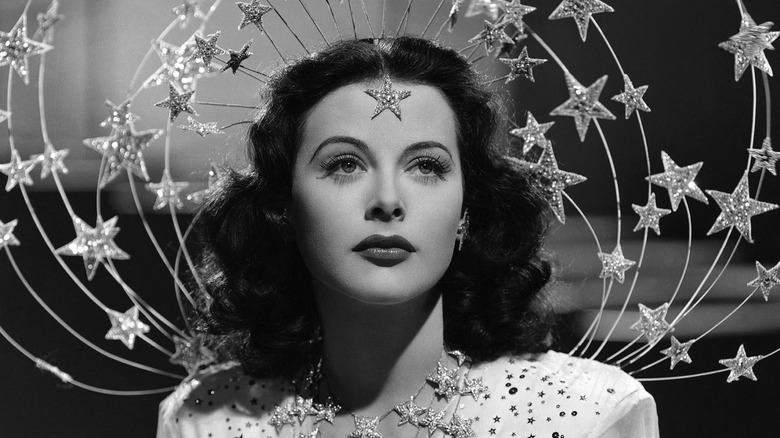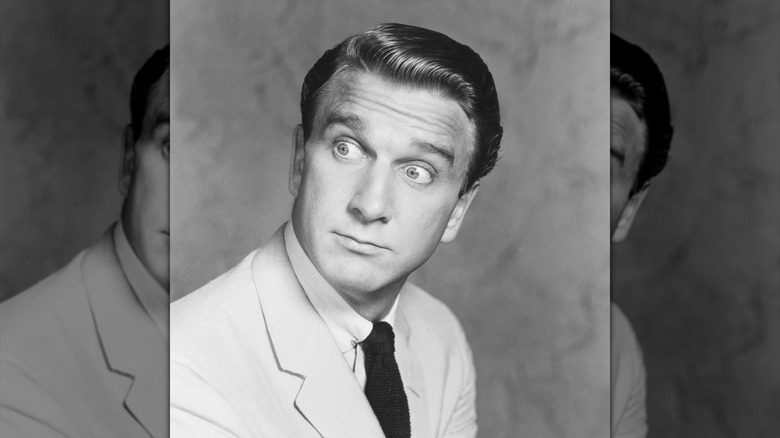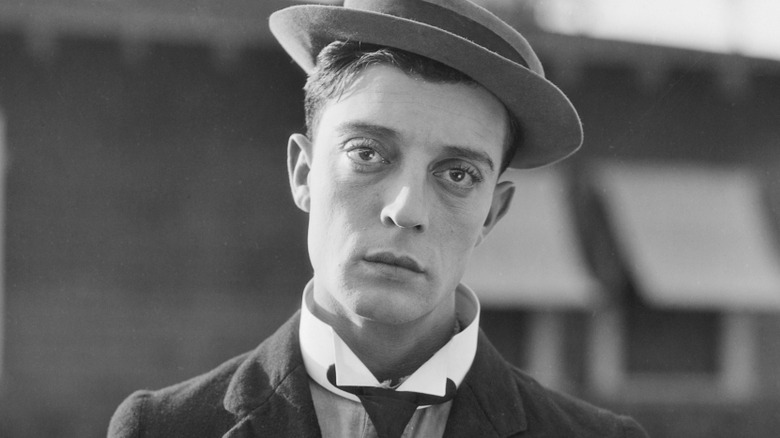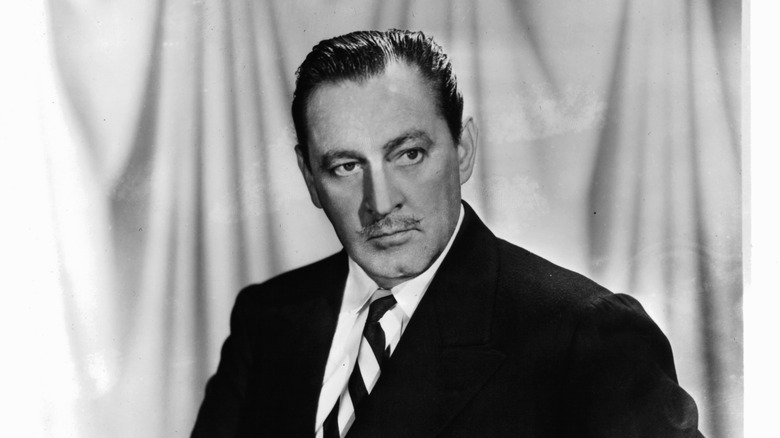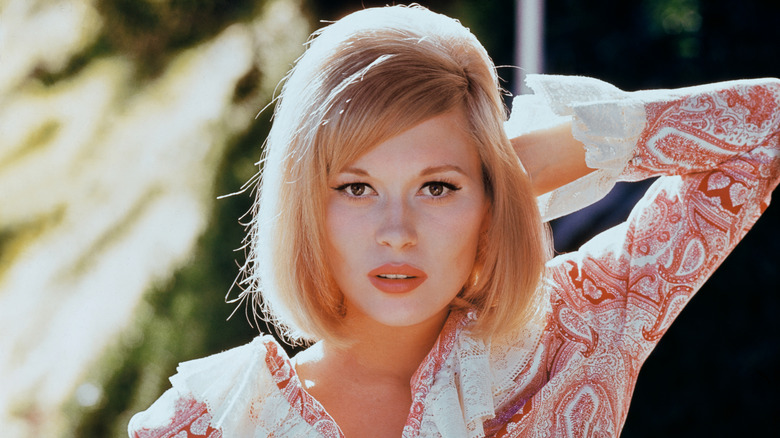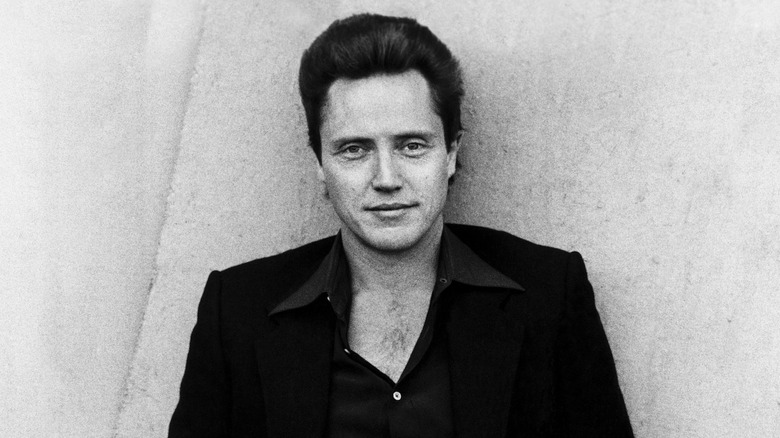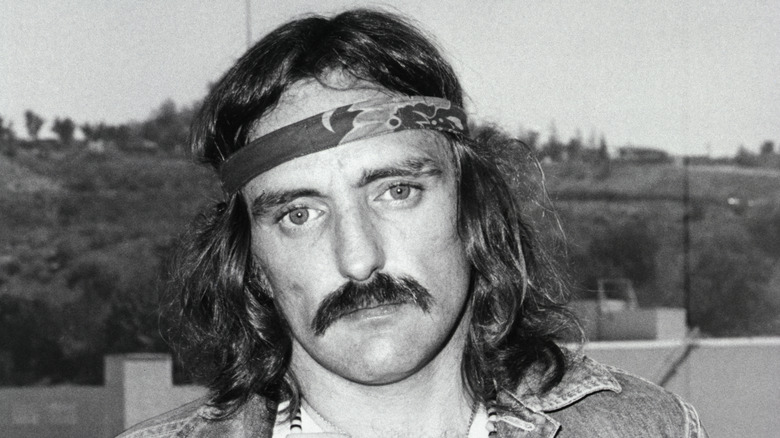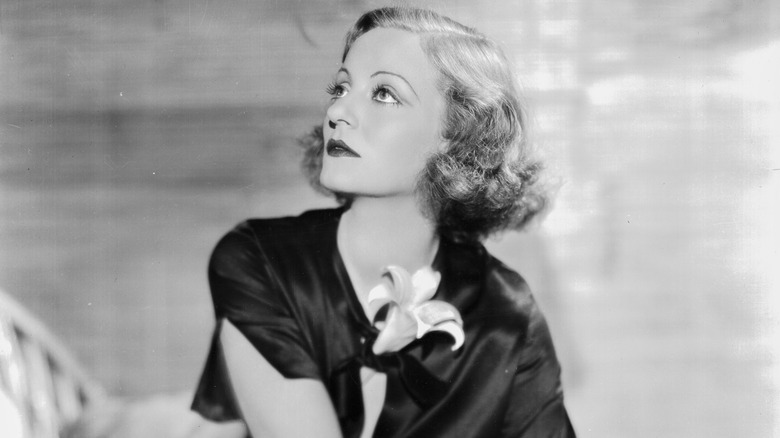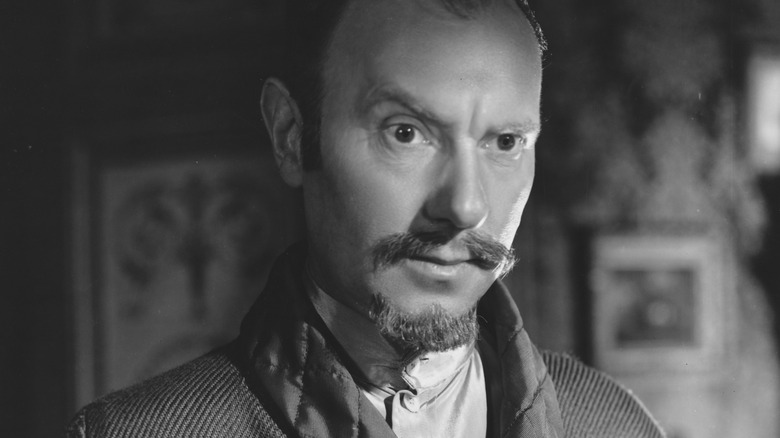Classic Film Stars Who Were Actually Really Weird People
"Old Hollywood" is a synonym for class, sophistication, and images of matinee idols chastely stealing kisses on the silver screen. But for many of the real-life actors playing those iconic parts, that's sure not how it felt at the time. For a start, things happened on classic movie sets that would be considered highly illegal today, and those Old Hollywood stars had a bunch of restrictive rules to follow. Behind the glitz and glamour, Golden Age Tinseltown had a darker, more eccentric side, and many of its stars had vices, addictions, and obsessions.
While many of the less savory aspects of those screen icons may seem familiar in modern times, and that some legendary stars were actually horrible people may come as no surprise, some were truly weird. From keeping pet lions to being obsessed with fake noses to being deathly afraid of the color purple, these classic film stars could be considered, at least in some manner, to actually be very weird people.
The following article mentions issues concerning addiction, child abuse, and mental health.
Cary Grant
In 1960, the editors at Good Housekeeping magazine got a strange call. Cary Grant, the suave, sophisticated film star who almost never gave interviews, was on the line and wanted to talk. The trouble was, the only thing he wanted to talk about was the magnificent amount of LSD he'd dropped. That, and the fact he now wanted everyone else to start dropping acid, too.
Born into a super-poor family in Bristol, with a cheating father and a mother who straight-up vanished (it later turned out the cheating father had needlessly had her committed to an insane asylum), Grant spent most of his acting life dealing with mental health issues. He was eventually introduced to LSD therapy by his third wife, and what happened in those sessions evidently blew his mind. From 1958 to 1961, Grant dropped acid a minimum of 100 times. But it didn't just make the inside of his head resemble the plot of "Yellow Submarine," it also turned him into an evangelical for his pick-me-up.
This is acid we're talking about, so the things Grant was evangelizing about sounded screwy at best. One vision Grant fondly recalled involved him turning into a gigantic wang and blasting off into space. It was only when the counterculture went acid crazy that Grant stopped dosing, lest his gentlemanly image clash with all those hippies.
Peter Lorre
If you've ever seen a film starring Peter Lorre, you've probably noticed his eyes: all droopy, like he's about to fall asleep. Lorre leveraged his looks into a long career playing oddballs and villains, but his distinctive expression may have had less to do with genetics and more to do with what substance the "Casablanca" actor was misusing. As it turns out, Lorre spent his entire career under the influence of morphine.
His substance misuse issues started long before he ever graced a Hollywood screen, following an appendix operation in his native Europe. His doctors kept the young actor so full of morphine that he wound up hopelessly addicted. By the time he appeared as the serial killer in Fritz Lang's disturbing German thriller "M," Lorre's addiction was so well-known in acting circles that his friends joked the "M" stood for "morphine." Little changed when he transitioned to Hollywood, where he also began misusing prescription pills and cough medicine.
For stretches of his career, Lorre was even choosing roles based on how they interfered with his drug misuse. He took the part of Mr. Moto in an eight-film series because he needed money for drugs, but also because they'd let him take them in his trailer. Whole films were shot with him so intoxicated that he could barely climb the stairs. And he still out-acted everybody else on set.
Orson Welles
Orson Welles, the actor, director, writer, producer, and general show-off, thought his nose was way too small for his rotund face. So he did what anyone with a studio makeup department at his beck and call would do. He had a whole slew of fake noses created for each role he played, and the bigger the better.
In nearly every movie appearance he made, Welles sported a fake nose. At the start of his career, these were relatively normal sizes. By the end, they were misshapen, bulging things that swelled out the center of his face like a lost alien chestburster making a dash for the nearest exit. And you better believe he was unwilling to work without them. When he took an acting gig on "Black Magic," while still trying to finish directing "Macbeth," concern over a box of misplaced noses took priority over his acting commitments.
When he finished a film, Welles kept his noses, named them, and stored them in his Hollywood home, where he would occasionally take them out at parties and perform magic tricks with them. That's the sort of weirdness you can get away with when you've directed the best film ever made.
Lupe Velez
Lupe Velez was known as "the Mexican spitfire," which was in many ways an accurate portrayal. Her countless outbursts ranged from staging fights in public to attending wrestling matches and screaming for blood, to unzipping Gary Cooper's fly at a social gathering and sniffing his crotch in an effort to detect whether he'd been seeing a man.
That last sentence highlights another of Velez's obsessions. In her life, Velez tore through men like an out-of-control combine harvester, but she could never shake her infatuation with Cooper. This may have been due to her assertion (via MIT) that the "High Noon" star had "the biggest organ in Hollywood," or it may have been due to the fact that Cooper was the only man on Earth who could keep up with her hellraising. Not that the two always got on; on one memorable occasion, an angry Velez stabbed him.
Tragically, Velez died by suicide. Beforehand, she adorned her apartment with flowers, lit candles, meticulously did her makeup, selected an outfit, and generally approached death as you would a fashion shoot.
Joan Crawford
Outwardly, Joan Crawford seemed like a woman living the dream. She was a three-time Oscar-nominated actress. She gave to charitable causes, adopting four children into her home. On the wild side, she had a steamy one-night stand with Marilyn Monroe. Inwardly, though, Crawford wasn't as wonderful as she seemed. According to her adopted daughter, Christina, she was an egomaniac who was consumed by jealousy.
The accusations came the year after Crawford died, when Christina published her infamous book "Mommie Dearest." An account of her time as Crawford's ward, it made the Hollywood star sound like the mother from hell. Tidbits included the revelations that Crawford had told Christina her birth mother was dead (she wasn't), scenes of Crawford having a meltdown when she discovered her daughter's dresses hung on wire hangers, and harrowing descriptions of the physical abuse Crawford occasionally unleashed on her children.
Christina's book has its detractors: Two of Crawford's other adopted children have disputed its account. Still, it remains plausible, partly because Crawford's behaviour is so well-documented elsewhere. She went through shady back channels to adopt her kids, resulting in one — who would have been her fifth — being reclaimed by his furious birth mother just days after arrival. There's also Crawford's legendary bitter rivalry with the equally strange Bette Davis, which culminated in Crawford sabotaging her own film's box office to stop Davis winning her third Oscar.
W.C. Fields
W.C. Fields may have been an actor, but the misanthropic, alcoholic jerk he played in all his movies wasn't a character. The real-life Fields was just as moody and intoxicated as the screen version.
The overweight, mottled star was more or less continuously drunk for his entire career. He was obsessed by the thought of being caught short without a drop, to the extent that he hoarded enough liquor in his attic to keep him going for 25 years. (One version of the story holds this was an insurance move in case Prohibition returned.) Inevitably, this impacted his career.
Late in life, Fields would demand $15,000 for each screenplay he wrote, and any producer foolish enough to stump up the cash would get some vague scrawlings on the back of an envelope — if that. Then there was the way he sometimes liked to just mess with regular folks. According to his old friend Groucho Marx, Fields used to hide behind bushes on his front lawn and shoot at passersby with a BB gun.
Peter Sellers
Peter Sellers, the British actor who gave us Doctor Strangelove, was privately perhaps stranger than even that legendary fictional weirdo. This wasn't a bumbling, goofy strangeness, either. By all accounts, Sellers was such a monumental butthead that few could stand to be around him.
Sellers was one of those acting legends who were nightmares in real life. He would have screaming meltdown tantrums on set. He'd freak out at his wives, smash crockery, and threaten them with his shotgun. He'd get low-level people fired on movies as a way of venting his frustrations against those — directors, producers — who were more powerful than he was. He was vaguely racist and profoundly superstitious. These traits combined when he worked with famed director Vittorio de Sica ("Bicycle Thieves") into a conviction that the Italian was a source of supernatural knowledge. All of which brings us to the color purple.
While working on "After the Fox," Sellers saw de Sica freak out at a script girl for wearing purple. The director told him it was the color of death, which Sellers took literally and became convinced the color purple could kill. He refused to be in rooms with it and would have yet more screaming tantrums if he came into contact with it.
Elizabeth Taylor
Elizabeth Taylor's hellraising is so infamous that our mental image of her can overshadow her actual work. While any cinephile could name a dozen actresses who could play Cleopatra, they'd be hard pressed to name any other actress whose private life was denounced by the Vatican.
Part of that denouncement was the social mores of the time. Part of it was straight-up misogyny. (How many perma-drunk male Casanovas get called out by the Pope?). At the same time, Taylor was as addicted to pleasure as she was to controversy. Over her lifetime, she married eight times, had endless affairs, got drunk at every opportunity, and took great pride in the offense she caused. Sometimes, her behavior was truly outrageous. After marrying and divorcing Richard Burton twice, Taylor was so upset that she got engaged just to spite him.
When working on Noel Coward's "Private Lives," Taylor and Burton brought out the worst in each other. They separately turned up drunk, broke character, and skipped performances. When Taylor missed a show, Burton got fed up, went to Vegas, and married Sally Hay. When Taylor heard the news, she was so furious that she announced her engagement to Victor Luna, upstaging Burton. Not that she ever hated her ex-husband. Later in life, Taylor claimed they would have married a third time if only Burton hadn't died.
Katharine Hepburn
The legendary screen goddess Katharine Hepburn was fiercely independent and lived life on her own terms, doing so with such steel that it may have appeared easier to change the entire world than for her to bend to social pressures. For starters, Hepburn had a fondness for romance with women but a disinclination to move that romance into the bedroom. She lived as if married to both women and men, all while acting like it was no big deal. For a woman to be doing that openly in the mid-20th century took iron resolve.
Admirable as Hepburn's life was, there was one area where her determination took her down a very strange path indeed. After allegedly trying intercourse just once and hating it, Hepburn became a passionate hater of nudity. This hatred wasn't just confined to the idea of her being personally naked with another naked person, or even to the idea of her encountering nudity in real life. Hepburn was so un-enamored with anything that even faintly whiffed of desire that she'd storm out of movies if a scene came on in which someone was au naturel.
Clark Gable
Whoever wrote the words "Cleanliness is next to godliness" was clearly lacking two things: access to a dictionary, and any knowledge of the life of Clark Gable. A heavy-drinking party animal, Gable was probably the antithesis of everything his contemporaries would consider godly. Yet there was one aspect of his personality that was apparently close to the Lord Almighty: Gable was obsessed with cleanliness.
Warren G. Harris' "Clark Gable: A Biography" includes an interview with an old Army buddy, who left no doubt that Gable hated anything that even remotely smacked of dirt. He shaved his chest and armpits, not because he was an Olympic swimmer or because he had a specific idea of male beauty, but because he hated the way a hairy body encouraged you to sweat more. He hated baths, too. This might seem odd in a guy who loved to be clean, but for Gable, having a bath meant sitting in your own filth as it saturated the water. During his time in the army, Gable carried around his own jerry-rigged portable shower.
This is even more remarkable when you consider Gable's on-set reputation for having atrociously bad breath. Vivien Leigh once complained that, when kissing him in "Gone With the Wind," "His dentures smelled something awful" (via The Guardian). For all his determination to keep his body clean, it seems flossing was never high on Gable's list.
Bette Davis
She was one of the last screen goddesses, but get on the wrong side of Bette Davis and she was liable to detonate with the force of a thousand classy A-bombs. Her mood could turn on a dime. Writing in Vanity Fair, the producer William Frye recalled meetings with the star that began well, only to end in the social equivalent of Armageddon. One time, Davis and Frye were meeting the director Herschel Daugherty for a meal when Daugherty made the mistake of wagging his finger in Davis' face. As Frye recalls it, Davis unleashed such a tirade on the director that she managed to clear out half the restaurant. Immediately afterward, she snapped back to being her usual self, like nothing had happened.
Legendary as Davis' temper was, her obsessive attention to detail was almost equally notorious, such as when a dog needed to be cast for her film "A Stolen Life." Rather than let a pet casting director (those exist) get involved, Davis personally auditioned every mutt in Los Angeles. The dog didn't even have a huge role; it was only in one key scene. Davis' efforts were wasted anyway, as the chosendog was too scared of her to do any canine acting.
Finally, there was her endless feud with Joan Crawford. There are numerous stories surrounding this, but the most Machiavellian may have been when Davis once spent an entire movie manipulating the crew to get Crawford fired.
Jimmy Stewart
James Stewart may have had a mild-mannered screen persona, but in real life he carried around a pair of stones forged from the purest steel. He flew a bomber over Europe in World War II when he was already famous, doing so spectacularly well that the French government awarded him the Croix de Guerre medal for his service during the liberation of France. Stewart even had it written into his Hollywood contracts that his war record could never be used to promote a movie. But perhaps the craziest bit of chutzpah-fueled greatness in Stewart's life was when he became an international smuggler.
The story gets even weirder when you hear what he was smuggling. Stewart was tasked with moving the mummified hand of a yeti from Nepal to the United Kingdom, which he accomplished by hiding it in his wife's lingerie. This was in the 1950s, at a time when it still seemed possible that there was an abominable snowman hiding out in the Himalayas somewhere. A group of Nepalese monks was known to have a rumoured yeti hand in their possession, and Stewart, who was in India at the time, was considered the best person to smuggle it out for testing. Sadly, it turned out to be fake.
Alec Guinness
The original Obi-Wan Kenobi, Alec Guinness was one of Britain's biggest screen icons. Classy, understated, and able to blend perfectly into any part, he was the quintessential Englishman. At least, on screen he was. Off screen, Guinness was a bizarre control freak who wouldn't let anyone make their own decisions and spent his every waking hour seeking to undermine his long-suffering wife.
In an interview with The Telegraph, Guinness' biographer, Piers Paul Read, revealed that nearly every meeting he'd had with Guinness over the years had been remarkably odd. Guinness apparently loved to meet for meals, where he'd ask everyone at the table what they wanted. The moment they replied, Guinness would declare, "No, no, you wouldn't like that!" then call the waiter over and order them the exact opposite. According to Read, Guinness had an obsessively precise idea of how every interaction should go and refused to be contradicted on such matters.
His home life was also odd. Guinness had grown up with an absent father and a mother who was a drunken thief, and his hatred of her had turned into a kind of reflexive misogyny. As an adult, this expressed itself in open resentment and belittling of his wife, Merula, whom he considered stupid. Weirdly, Read suggests Guinness recognized his own jerkbag nature and desperately tried to keep it bottled up, only to have it come seeping out. Merula, for her part, seems to have decided to ignore her husband's oafishness.
Greta Garbo
Greta Garbo was a total recluse who hated venturing out so much that she once managed to miss her own wedding. Just about the only person she allowed in was Gayelord Hauser, who just happened to be a nutritionist with a sideline in crazy. He convinced Garbo to spend decades following his dietary plans, and she became so obsessed with their purported health benefits that she subjected herself to meals the U.N. would class as biological weapons.
One involved eating nothing but raw yeast, with occasional treats of buttermilk. Another involved Garbo dining only on spinach for a full three weeks. Luckily, she abandoned that diet before she had to choose between going to the hospital and trading blows with Bluto down at the dockyards.
Hauser liked to claim that following his bonkers diet plans would allow anyone to live to 100. In absolute fairness, both he and Garbo came close, dying at 89 and 84, respectively, but there was no word as to whether they thought it was remotely worth it.
Tippi Hedren
Tippi Hedren is best known to film fans for acting terrified of flocks of birds in Alfred Hitchcock's 1963 thriller "The Birds." But once you find out about Hedren's pet of choice, you'll have trouble believing Hedren acting scared of any animal ever again. The actress shared her Hollywood home with the scariest animal of all: a fully grown, 400-pound male lion.
This unlikely setup developed from Hedren's conservation work, and not just some celebrity trying to impress other celebrities Pablo Escobar-style by having their own menagerie. She's been active in the field of saving big cats for decades and has won a host of awards for her efforts. Hedren's lion, Neil, had the run of the house and would saunter through the living room when guests were visiting. At the time, Hedren was living with her teenage daughter, Melanie Griffith. Every now and then, she'd let Griffith and Neil share a bed, which is exactly as terrible an idea as it sounds.
Thankfully, Neil didn't maul Hedren, eat Griffith, or kill any guests. However, they later got other lions and each family member was attacked at one time or another, and Griffith needed facial reconstruction after being badly mauled once. Hedren has since changed her mind and now admits (via Time) that keeping a lion in her house was "stupid beyond belief."
Marlon Brando
Marlon Brando is regarded as the most talented actor of his generation, but he was also a world-class eccentric with a penchant for odd behavior that grew increasingly bizarre as he grew older. For example, in his autobiography, "Brando: Songs My Mother Taught Me," Brando wrote about the menagerie of unusual pets he'd owned over the years, ranging from electric eels to monkeys to an anteater named Chuck. However, he was most fond of his pet raccoon, Russell, who lived in his New York City apartment when he was an up-and-coming actor, and once dismantled Brando's wristwatch, right down to the springs.
Meanwhile, stories about Brando's weird behavior abound. For example, after the death of his best friend, actor Wally Cox, Brando regularly conducted conversations with his friend's cremated remains. Even stranger was the claim that while filming the 1976 western, "The Missouri Breaks," he reportedly grabbed a frog from a stream, took a bite out of it, and tossed it back into the water.
In addition, there have been various anecdotes about his refusal to learn his lines, instead having them written on notes hidden on the set or even taped to his co-stars. Arguably, some of Brando's strangest on-set moments came while making 1996's "The Island of Dr. Moreau," when he insisted his character, the titular mad scientist, wear an ice bucket as a hat, and pushed for a twist ending revealing his character was actually a dolphin.
Klaus Kinski
During a screen career spanning from the late 1940s until his 1991 death, Klaus Kinski was renowned for both his intense performances and his violently unhinged behavior. Kinski became notorious for terrorizing directors and engendering outright hatred from crew members. One infamous incident occurred while filming "Aguirre: The Wrath of God," when he became so irritated by noise coming from a hut in which some crew members were playing cards that he fired a rifle at them, blowing off a man's finger. Kinski was also famed for enraging Berlin theater-goers with his one-man show about the life of Jesus Christ, which devolved into Kinski exchanging insults with jeering audience members.
Despite making several films together, Kinski's frequent collaborator, director Werner Herzog, detailed their turbulent relationship in a documentary, "My Best Fiend." Herzog recalled Kinski once locking himself in a bathroom for two days and trashing it, to the point that what remained could be sifted through a tennis racket. "I never thought anyone could rave for 48 hours," Herzog mused, via IFC Center. In his memoir, "All I Need is Love," Kinski wrote, "Herzog is a miserable, spiteful, envious, sadistic, insidious, backstabbing, blackmailing, cowardly person ..."
A possible explanation for Kinski's erratic behavior emerged in 2008, when German tabloids published confidential information about Kinski's three-day stay in a psychiatric facility when he was 26. Doctors offered a preliminary diagnosis of schizophrenia and labeled him a psychopath.
Hedy Lamarr
Film buffs may remember Hedy Lamarr as a Hollywood beauty who lit up the screen in such films as "Samson and Delilah" and "White Cargo." Those who simply knew her as a movie star, however, likely had no idea that her good looks were eclipsed by a brilliant mind. While her peers would conclude a day of filming by carousing at trendy nightclubs, Lamarr would instead spend her evenings tinkering at the "inventing table" in her home. "Hedy had a drafting table and a whole wall full of engineering books. It was a serious hobby," historian Richard Rhodes, author of "Hedy's Folly: The Life and Breakthrough Inventions of Hedy Lamarr, the Most Beautiful Woman in the World," told History.
In the early years of World War II, she met musical composer George Antheil, who also had a knack for inventing. Eager to contribute to the war effort, the two bonded and began working together on a communications system in which frequencies within radio waves jumped from one to another so they couldn't be intercepted. They were awarded a patent, but the U.S. military declined to utilize that system.
It wasn't until after her death that Lamarr's frequency-hopping invention was recognized by the scientific community as having paved the way for today's wireless technology, including Bluetooth and GPS. As the National Women's History Museum noted, Lamarr was posthumously dubbed "the mother of WiFi."
Leslie Nielsen
Canadian actor Leslie Nielsen launched his career as a dramatic actor during television's so-called "Golden Age," and he appeared in numerous TV series throughout the early 1950s. He went on to star in the 1956 sci-fi classic "Forbidden Planet," and was a ubiquitous figure in TV and film throughout the 1960s and '70s. It was his role in the 1980 comedy "Airplane!" that opened up a whole new career path as a deadpan funnyman, hitting his zenith as dippy Detective Frank Drebin in "The Naked Gun" and its sequels.
During Nielsen's second act as a comedy superstar, he enjoyed bringing his beloved "Han-d-Gas" device with him to interviews, a small item he held in his hand that produced a sound akin to that of passing wind. Utilized while visiting "Late Night with Conan O'Brien," Nielsen went on to employ his so-called "fart machine" with him during numerous TV interviews over the years. In fact, Nielsen confirmed he didn't just use the device on talk shows, but brought it with him everywhere, and particularly enjoyed unleashing it in crowded elevators.
Perhaps Nielsen's most hilarious use of the device took place during a 2003 press junket, when his frequent blasts of gas unsettled the interviewer — who was apparently unfamiliar with the device — and claimed to be experiencing gastrointestinal distress brought about by a dodgy piece of salmon. Nielsen proceeded to hilariously derail the interview with a steady stream of perfectly timed fake flatulence.
Buster Keaton
Silent film comedian Buster Keaton came to fame for his inventive stunts. Capturing these moments on film, however, was no mean feat, and Keaton regularly risked life and limb in ways most people would deem foolhardy.
Chief among these was one absolutely terrifying sequence when the entire wall of a house fell on him, only to leave him unscathed because he was standing in the precise spot of a precisely placed open window. It was all carefully planned, yet there was no guarantee that things wouldn't go terribly wrong and leave him severely injured or worse. According to Hollywood lore, the cameramen filming the stunt looked away, while the director was somewhere else entirely. "I think the director did actually confirm years later that he was in fact off in his tent — in his office, praying that the stunt would go off," film critic Dana Stevens told NPR's "Fresh Air." "You know, people were fainting on the sidelines because it really was the most dangerous stunt he'd ever undertaken — you know, something that, if it had been a fraction of an inch off, could have crushed him."
That trait, however, is something that had been inherent in Keaton since infancy. A famous story involved baby Keaton falling down an entire flight of stairs while his horrified parents watched — only for him to bounce up unscathed, as if nothing happened.
John Barrymore
John Barrymore was a member of an acting dynasty in the early days of Hollywood, along with siblings Lionel and Ethel. While he's far better known as the grandfather of Drew Barrymore, he was once seen as one of the finest actors of his generation. When he shifted his talent from stage to screen, the money he earned in Hollywood gave him the latitude to indulge both his enormous appetites and his various eccentricities. That was evident in his lavish mansion, which contained his own personal opium den, an aviary housing 500 birds, and a collection of strange artifacts (which included shrunken heads and a totem pole stolen from a village in Alaska).
Film star Errol Flynn was a close friend of Barrymore, and wrote about one of the actor's most unusual peculiarities in his posthumously published autobiography, "My Wicked Wicked Ways." "[John] thought it was a waste of time to go to the bathroom if there was a window close by," Flynn wrote, complaining that Barrymore's habit of urinating out a specific window had, over time, stripped all the varnish from the wooden sill.
When Flynn pointed this out, asking his friend to find an alternative way to answer nature's call, Barrymore declared, "Certainly m'lad." He then shifted his attention from the window and instead took aim at Flynn's fireplace. "The smell through the room was atrocious," Flynn wrote.
Faye Dunaway
Following her breakout in 1967's "Bonnie and Clyde," Faye Dunaway went on to become one of the biggest female movie stars of the 1970s, appearing in such critically acclaimed box office hits as "The Thomas Crown Affair," "Chinatown," and "Network." As Dunaway's stardom grew, so too did reports that she was difficult to work with.
Eventually, strange stories began to emerge. There was, for example, her clash with "Chinatown" co-star Jack Nicholson, who began referring to her as "The dreaded Dunaway" (via Far Out). The film's director, Roman Polanski, felt similarly when he described her to Rolling Stone as "a gigantic pain in the ass," adding, "You have, I guarantee, never seen such certifiable proof of craziness." Even Hollywood legend Bette Davis — who'd co-starred with Dunaway in a TV movie — couldn't conjure up anything positive to say when, during an appearance on "The Tonight Show," she declared, "She's a very unprofessional, difficult woman."
Among the stranger reports about Dunaway came in 2016, when she attended the amfAR gala and, when dinner was served, pulled a small kitchen scale from a paper bag and began weighing her food. A rep for the actor offered an explanation. "Ms. Dunaway has always taken care of her diet and general wellbeing, what may be considered slightly eccentric is part of her charm," the rep told the Daily Mail.
Christopher Walken
Few actors have enjoyed the career longevity of Christopher Walken, who began his journey as child star Ronnie Walken before transitioning to adult roles in the 1960s. Walken is now iconic for his quirky line readings, but has also developed a reputation for world-class weirdness. David Spade, during an appearance on "Jimmy Kimmel Live!" recalled working with Walken on "Joe Dirt" and listening to him discuss the relative acting abilities of various animals, and mice in particular. "They're good," Spade recalled Walken observing. "You tell a mouse to walk up here, take a beat, and go left, and they do it."
Seann William Scott worked with Walken in "The Rundown," and once noticed that Walken appeared exceptionally glum. "And I was like, 'Christopher Walken ... Is everything OK? You look all sad,'" Scott said in a since-deleted Facebook Live post (via Yahoo! Entertainment). Walken confirmed he was down, complaining it was his birthday and that he never received a cake, which Scott immediately offered to procure. "And then he looks at me, he goes, 'I'm just kidding, it's not my birthday. But I'll say it is in a week and I guarantee you they'll bring me a cake...' It was the weirdest thing," Scott said.
As Walken predicted, Scott later witnessed the cast and crew singing "Happy Birthday" to Walken as he blew out the candles on his cake. "And he looks over me and [winks]. It wasn't his birthday!" Scott added.
Dennis Hopper
It's no secret that drugs were prevalent in Hollywood during the 1960s and '70s, but few actors indulged with the gusto of Dennis Hopper. As the years passed, so too did the escalation of Hopper's drug and alcohol misuse. Prior to getting sober late in life, Hopper recalled the depths he'd sunk to in an interview with Cigar Aficionado. "I was drinking a half-gallon of rum with a fifth of rum on the side, in case I ran out, 28 beers a day, and three grams of cocaine just to keep me moving around," Hopper said, recalling the cocaine kept him awake so he could continue drinking.
That level of substance misuse left him in a perpetually altered state, which manifested itself in some seriously strange behavior and caused his innate paranoia to escalate considerably. "Dennis was just a paranoid person," observed "Easy Rider" co-star Peter Fonda to The Times.
By the early 1980s, Hopper was far gone. "He was hardcore. He went insane," Hopper's friend, Ron Davis, told Trend magazine, recalling watching Hopper on the roof of his home, firing a gun at helicopters only he could see. Eventually, Hopper came to believe the mafia had ordered a hit on him. Fancifully fearing he was about to be whacked by the mob, he fled to Mexico, where he walked into a jungle, stark naked, in the darkness of the night.
Tallulah Bankhead
Tallulah Bankhead gained fame via the London theater scene before heading to Hollywood. While she never attained the level of stardom that had been predicted, she was dedicated to having a good time. Yet that party-girl persona was also tinged with danger. As The New Yorker noted, Joan Crawford once quipped, "We all adored her. We were fascinated by her, but we were scared to death of her, too ..."
Bankhead demonstrated a flair for exhibitionism, and earned a reputation for doffing her clothing at parties. She was also known to leave her bathroom door whenever nature called, and was loath to wear any underwear. That created something of a scandal when she went commando while performing in a play, which resulted in so many audience members complaining that Actors' Equity issued an edict ordering her to wear underpants whenever she appeared onstage.
Stefanie Powers, who co-starred with Bankhead in the 1965 film "Die, Die, My Darling," certainly got to know that side of Bankhead. "She was not only a perfomer, but she was a bit of an exhibitionist," Powers once said (via CBS News), recalling her surprise when Bankhead once summoned her to her dressing room. "And frequently she might be sitting naked on the toilet," Powers recalled. "This was not necessarily an attractive sight, but it was her way. She loved shock value!"
Ralph Richardson
British actor Ralph Richardson was renowned for his adeptness at portraying a wide range of characters, yet he also possessed a penchant for mischief that pushed the envelope in some socially unacceptable ways. For example, he once attempted to impress Vivien Leigh and her husband, Laurence Olivier, by surprising them with a fireworks display in their garden, while they threw a party. However, when he fired the first rocket, it unexpectedly changed paths and exploded in her drawing room, terrifying guests and destroying furniture.
Leigh was not amused, and banned Richardson from ever setting foot in their home ever again. That ban was eventually lifted several years later, and he paid another visit, which proved to be an even bigger disaster. While Richardson was admiring some medieval frescoes in the home's attic, he stepped off a beam in order to get a closer view, only to lose his footing and crash right through their bedroom ceiling.
While that may have been an accident, there was nothing accidental when Olivier asked Richardson to do him a favor: to call his wife to let her know he'd be late for dinner. Instead of calling Leigh, the actor's current wife, Richardson instead called Olivier's ex-wife, Jill Esmond, declaring, ”Larry says not to worry, he'll be home in 20 minutes.”
If you or anyone you know needs help with addiction issues, may be the victim of child abuse, needs help with mental health, or is struggling or in crisis, contact the relevant resources below:
-
The Substance Abuse and Mental Health Services Administration website or contact SAMHSA's National Helpline at 1-800-662-HELP (4357).
-
The Childhelp National Child Abuse Hotline at 1-800-4-A-Child (1-800-422-4453) or contact their live chat services.
-
The Crisis Text Line by texting HOME to 741741, call the National Alliance on Mental Illness helpline at 1-800-950-NAMI (6264), or visit the National Institute of Mental Health website.
-
Call or text 988 or chat 988lifeline.org

